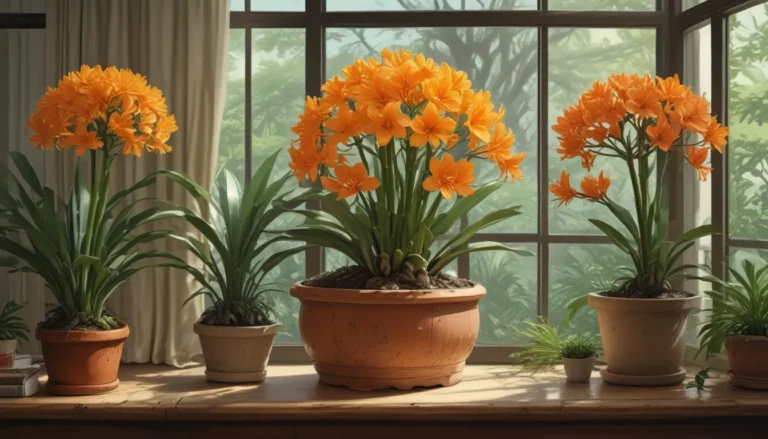How to Grow and Care for Blood Lilies: A Comprehensive Guide

If you’re a fan of unique and striking blooms, then the blood lily might be just the plant for you. With its crimson-colored, globe-shaped flowers, the blood lily, or Scadoxus multiflorus, is a stunning addition to any garden.
As we dive into the realm of blood lilies, we’ll explore everything you need to know about these vibrant plants, from their history and cultivation to propagation and care. Let’s start by understanding what blood lilies are all about.
What Are Blood Lilies?
Scadoxus multiflorus, also known as the blood lily, is a bulbous perennial from the Amaryllidaceae family. Originating from tropical Africa, parts of South Africa, and the Arabian Peninsula, the blood lily is known for its striking red blooms.
Contrary to its name, the blood lily is not a true lily plant but still offers a unique and beautiful addition to any garden. With spherical flower heads composed of many individual blooms, the blood lily stands out with its distinct appearance and fiery colors.
Cultivation and History
Beyond its aesthetic appeal, the blood lily has a rich history and practical applications in various cultures and regions. In Africa, this plant is used for protection, marking boundaries, and even medicinal purposes.
With its intriguing history and cultural significance, the blood lily offers more than just beauty. Its blooms and foliage hold both visual appeal and practical uses, making it a fascinating addition to any garden.
Propagation
To grow blood lilies, you have several options for propagation, including seed sowing, dividing offsets, planting bulbs, or transplanting potted specimens. Each method offers a unique way to expand your blood lily collection and enjoy their vibrant blooms.
Whether you choose to start from seed, divide offsets, or transplant bulbs, blood lilies can be propagated successfully with patience and care. With the right approach, you can multiply your plant collection and enjoy the beauty of these unique flowers.
Growing Tips
- Provide full to partial shade exposure.
- Water when the surface of the soil dries out.
- Fertilize regularly during the growing season.
How to Grow Blood Lilies
Once you have your blood lilies planted, it’s essential to understand how to care for them properly. From climate and exposure needs to soil requirements and water management, here are some key tips for growing healthy and vibrant blood lilies.
Climate and Exposure Needs
Blood lilies thrive in USDA Zones 9 to 11, requiring full sun to partial shade exposure. Whether grown indoors or outdoors, these plants benefit from bright, indirect light and well-drained, fertile soil.
Soil Needs
The ideal soil for blood lilies is organically rich, fertile, and well-draining with a slightly acidic pH. Amending your soil with compost or well-rotted manure can improve its structure and provide essential nutrients for healthy plant growth.
Water and Fertilizer Needs
Maintain even moisture throughout the growing season by watering when the soil surface dries out. Regular fertilization with a balanced fertilizer can help promote strong blooms and healthy foliage, ensuring your blood lilies thrive.
Pruning and Maintenance
Proper pruning and maintenance can help keep your blood lilies healthy and blooming. From deadheading spent flowers to cutting back foliage, a few simple tasks can enhance the appearance and longevity of your plants.
Whether you’re growing blood lilies as a cut flower or accent planting, regular maintenance and care can ensure your plants thrive and continue to brighten your garden.
Managing Pests and Disease
While blood lilies are generally resistant to pests and diseases, it’s essential to remain vigilant and prepare for potential issues. From slugs and snails to bulb rot, understanding common problems and taking proactive measures can help protect your plants and promote their health.
By following best practices for pest management and disease prevention, you can enjoy vibrant and healthy blood lilies in your garden for years to come.
Best Uses for Blood Lilies
Blood lilies offer a variety of uses in the garden, from accent plantings to cut flowers. Whether grown in containers, borders, or as indoor houseplants, these striking blooms add color and beauty to any space.
With their versatile nature and bright red blooms, blood lilies can serve as focal points or support other plants in a garden design. Their unique appearance and easy care make them a valuable addition to any landscape.
Quick Reference Growing Guide
Plant Type: Bulbous flowering perennial
Flower/Foliage Color: Red/green
Native to: Tropical Africa, Arabian peninsula
Maintenance: Moderate
Hardiness (USDA Zone): 9-11
Tolerance: Being root-bound, deer, rabbits, rodents
Bloom Time/Season: Summer
Soil Type: Rich, moderately moist
Exposure: Full sun to partial shade
Soil pH: 5.5-6.5
Time to Maturity: Within a year (from bulbs), up to 5 years (from seed)
Soil Drainage: Well-draining
Spacing: 9-18 inches
Attracts: Bees, birds, butterflies
Planting Depth: 1 inch
Uses: Accent, cut flower, houseplant, container planting, specimen
Height: 1-2 feet
Spread: 9-18 inches
Water Needs: Moderate
Common Pests and Diseases: Slugs and snails; root rot
Genus: Scadoxus
Species: Multiflorus
Final Thoughts
In conclusion, growing and caring for blood lilies can be a rewarding experience for any gardener. With their vibrant blooms, easy maintenance, and unique characteristics, these plants offer beauty and interest in any landscape.
By following the tips and guidelines outlined in this comprehensive guide, you can successfully cultivate and enjoy blood lilies in your garden. Whether you’re a seasoned gardener or a novice plant enthusiast, blood lilies are a valuable addition to any collection.
I hope this article has provided you with valuable information and insights into the world of these captivating plants. If you have any questions, concerns, or tips to share, feel free to leave a comment below. Happy gardening!





